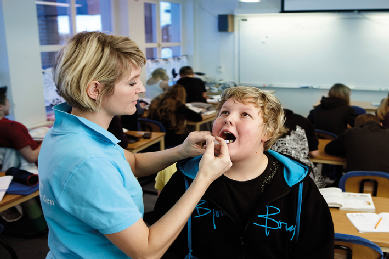Sweden - School based fluoride varnish application programme
Sweden - School based fluoride varnish application programme
Introduction
A school-based fluoride varnish application programme for adolescents by the Public Dental Service,
was implemented in 2008 in the Västra Götaland Region, Sweden.
Background
Previously, a fluoride varnish study by Moberg Sköld et al. (2005), conducted on adolescents at school in the
same region in Sweden showed a significant reduction of new approximal caries in medium and high risk
caries areas.
This lead initially to implementing a fluoride varnish programme for adolescents in schools in some parts of
Västra Götaland in 2003. In 2008, this programme was extended to include all 112 Public Dental Clinics
serving the region.
Programme Outline
This programme for the 12- to 15- year-old schoolchildren was carried out by dental nurses from the
Public Dental Services in the Västra Götaland Region.
- Every six months, the dental nurses met with the 12- to 15-year-olds (6th - 9th classes) at school in small
groups for fluoride varnish applications (Duraphat®, 2.26% F). - First, the adolescents flossed their teeth under supervision.
- Then fluoride varnish application was made using a syringe. Fluoride varnish was applied to all approximal surfaces from the distal surface of the canine to the mesial surface of the second molar.
- The adolescents also took part in two lessons about oral hygiene and tobacco use.
- This programme was in addition to tooth brushing with fluoridated toothpastes at home and the regular
dental check up at the public dental clinics, every 18 months if the caries risk is low to medium. - The small number of children adolescents with high caries risk attended the clinics every 12 months and
received additional treatment. - In 15 high caries risk areas, the school-based fluoride varnish programme started already when
the schoolchildren were six years old (2003) and the number of fluoride varnish treatments at school
were 4-8 times per year, for the adolescents. - In general, the fluoride varnish was the common caries prevention that all the adolescents received
in this region.


Achievements
- Caries increment was calculated on those adolescents who attended their regular check-up
both at age 12 and at age 15 showing a total approximal caries increment (DFSa + DeSa) from 12
to 15 years of 1.41 for Group 1 (Intervention 2003), 1.60 for Group 2 (control) and
1.09 for Group 3 (Intervention 2008). - Caries prevalence and caries increment in 15 year olds were significantly lower after the implementation
of the programme. - The control group without an intervention programme, had the highest caries increment.
- The cost analysis showed that it was a break-even between costs and gains due to prevented
fillings at the age of 15.


Conclusion
This school-based fluoride varnish programme, implemented on a broad scale for all 12- to 15-year-olds,
contributed to a low caries increment at a low cost for the adolescents in the Västra Götaland Region.
References
Bergström EK, Lingström P, Hakeberg M, Gahnberg L, Sköld UM. Caries and costs: an evaluation of a school-based
fluoride varnish programme for adolescents in a Swedish region. Community Dent Health. 2016;33:138-44.
Moberg Sköld U, Petersson LG, Lith A, Birkhed D. Effect of school-based fluoride varnish programmes on approximal
caries in adolescents from different caries risk areas. Caries Res. 2005;39:273-279.
Acknowledgement
We thank the Public Dental Service Folktandvården, Västra Götaland, for giving us the permission to publish
the pictures for this presentation.
by Stjernswärd J and Bergström E-K.
